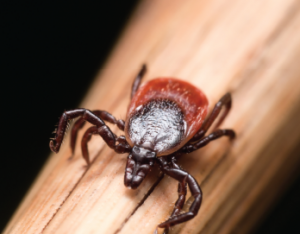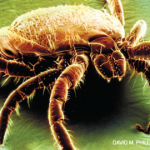
A bite from an infected tick can lead to symptoms of Lyme disease within one to four weeks.
Steven Ellingson/shutterstock.com
CHICAGO—A clustering of cases in Lyme, Conn., in 1975 led to the discovery of Lyme disease. Allen C. Steere, MD, professor of medicine at Harvard Medical School in Boston, investigated that outbreak, and he shared his knowledge of Lyme disease with rheumatologists gathered at the ACR’s State-of-the-Art Clinical Symposium in April. He explained that Lyme arthritis was recognized as a separate disease because of the clustering of the children in Lyme, and since that time, the number of cases of Lyme disease in the U.S. has increased significantly.
Absent antibiotic treatment, Lyme disease unfolds in stages. When the infection begins, it is typically localized to the skin where it causes a slowly expanding skin lesion, often associated with such symptoms as neck stiffness, headache and arthralgias. Stage two follows weeks to months after infection and patients can experience Lyme neuroborreliosis, which presents as acute neurologic involvement, lymphocytic meningitis, cranial neuritis and/or sensory or motor radiculopathy. Patients may also experience Lyme carditis with atrioventricular block. The late stage of Lyme disease happens months to years after disease onset. The most common manifestation of late disease is Lyme arthritis, which presents in one or a few joints, most commonly the knee. Typically, patients in this stage do not have systemic symptoms. Late Lyme neuroborreliosis may also rarely occur in late-stage Lyme disease, and it is characterized by subtle encephalopathy or sensory polyneuropathy.
Diagnosis
Diagnosis of Lyme disease requires a combination of characteristic clinical signs and symptoms and known exposure to an endemic area. Physicians can use serological tests to confirm infection, and the results are interpreted according to the criteria of the Centers for Disease Control and Prevention and the Association of State and Territorial Public Health Laboratory Directors. During the first 30 days of symptoms, at least two of three IgM bands are required for a positive test result. At any time of illness, at least five of 10 IgG bands are required. Dr. Steere emphasized that “there can be false-positive IgM responses,” but the IgG criteria have high specificity.
Most patients do not test seropositive during the first several weeks of infection, but by convalescence, these patients often seroconvert. By late infection, virtually every patient is IgG seropositive. After appropriate antibiotic treatment, the amount of specific antibody declines, but the Western blot, a nonquantitative test, does not change much. This does not mean that they are still infected.
At any time of illness, at least five of 10 IgG bands are required [for diagnosis of Lyme]. Dr. Steere emphasized that ‘there can be false-positive IgM responses,’ but the IgG criteria have high specificity.
Treatment
“Treatment of Lyme disease is often straightforward,” explained Dr. Steere, “but arthritis may be harder than that.” Thus, rheumatologists should treat Lyme arthritis with an algorithm, beginning with doxycycline therapy. Dr. Steere explained that although doxycycline usually works, there are patients in whom the arthritis does not change much after 30 days of treatment with oral antibiotic therapy. Some of these patients then respond to IV antibiotic therapy. Ceftriaxone is most commonly used for that purpose.


